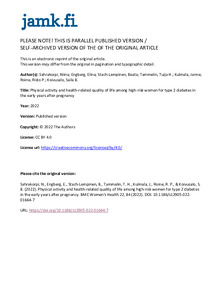Physical activity and health-related quality of life among high-risk women for type 2 diabetes in the early years after pregnancy
Sahrakorpi, Niina; Engberg, Elina; Stach-Lempinen, Beata; Tammelin, Tuija H.; Kulmala, Janne; Roine, Risto P.; Koivusalo, Saila B. (2022)
Sahrakorpi, Niina
Engberg, Elina
Stach-Lempinen, Beata
Tammelin, Tuija H.
Kulmala, Janne
Roine, Risto P.
Koivusalo, Saila B.
Biomed central
2022
Julkaisun pysyvä osoite on
https://urn.fi/URN:NBN:fi-fe2023022728717
https://urn.fi/URN:NBN:fi-fe2023022728717
Tiivistelmä
Background
Previous studies have shown that physical activity (PA) correlates positively with health-related quality of life (HRQoL) in the general population. Few studies have investigated associations between device-measured PA and HRQoL among premenopausal women at risk for type 2 diabetes (T2D). In addition to physical well-being, general well-being improved by PA has been suggested to strengthen PA’s benefits in reducing metabolic diseases. The aim of this study was to examine the associations between PA and HRQoL (general and dimensions) among high-risk women in the early post-pregnancy years when T2D risk is highest and to estimate whether current obesity or prior gestational diabetes (GDM) modified these associations.
Methods
This cross-sectional study of high-risk women [body mass index (BMI) ≥ 30 kg/m2 and/or prior GDM)]4–6 years after delivery measured sleep, sedentary time, daily steps, and light (LPA), moderate-to-vigorous (MVPA), and vigorous PA (VPA) with the SenseWear ArmbandTM accelerometer for seven days and HRQoL with the 15D instrument.
Results
The analyses included 204 women with a median (IQR) age of 39 (6.0) years and a median BMI of 31.1 kg/m2 (10.9). 54% were currently obese (BMI ≥ 30 kg/m2), and 70% had prior gestational diabetes (GDM+). Women with obesity had lower PA levels than women with normal weight or overweight (p < 0.001) but there was no difference between the GDM+ or GDM− women. Women with both current obesity and GDM+ had highest sedentary time and lowest PA levels. The whole sample’s median 15D score was 0.934 (IQR 0.092), lower among women with obesity compared to the others (p < 0.001), but not different between GDM+ or GDM−. There was a positive correlation between VPA (adjusted rs = 0.262 p = 0.001) and the 15D score. After grouping according to BMI (< and ≥ 30 kg/m2), the associations remained significant only in women without obesity. Among them, sleep, total steps, MVPA, and VPA were positively associated with 15D.
Conclusions
Higher PA levels are associated with better HRQoL among high-risk women with normal weight and overweight but no differences were found among women affected by obesity in the early years after pregnancy.
Previous studies have shown that physical activity (PA) correlates positively with health-related quality of life (HRQoL) in the general population. Few studies have investigated associations between device-measured PA and HRQoL among premenopausal women at risk for type 2 diabetes (T2D). In addition to physical well-being, general well-being improved by PA has been suggested to strengthen PA’s benefits in reducing metabolic diseases. The aim of this study was to examine the associations between PA and HRQoL (general and dimensions) among high-risk women in the early post-pregnancy years when T2D risk is highest and to estimate whether current obesity or prior gestational diabetes (GDM) modified these associations.
Methods
This cross-sectional study of high-risk women [body mass index (BMI) ≥ 30 kg/m2 and/or prior GDM)]4–6 years after delivery measured sleep, sedentary time, daily steps, and light (LPA), moderate-to-vigorous (MVPA), and vigorous PA (VPA) with the SenseWear ArmbandTM accelerometer for seven days and HRQoL with the 15D instrument.
Results
The analyses included 204 women with a median (IQR) age of 39 (6.0) years and a median BMI of 31.1 kg/m2 (10.9). 54% were currently obese (BMI ≥ 30 kg/m2), and 70% had prior gestational diabetes (GDM+). Women with obesity had lower PA levels than women with normal weight or overweight (p < 0.001) but there was no difference between the GDM+ or GDM− women. Women with both current obesity and GDM+ had highest sedentary time and lowest PA levels. The whole sample’s median 15D score was 0.934 (IQR 0.092), lower among women with obesity compared to the others (p < 0.001), but not different between GDM+ or GDM−. There was a positive correlation between VPA (adjusted rs = 0.262 p = 0.001) and the 15D score. After grouping according to BMI (< and ≥ 30 kg/m2), the associations remained significant only in women without obesity. Among them, sleep, total steps, MVPA, and VPA were positively associated with 15D.
Conclusions
Higher PA levels are associated with better HRQoL among high-risk women with normal weight and overweight but no differences were found among women affected by obesity in the early years after pregnancy.
